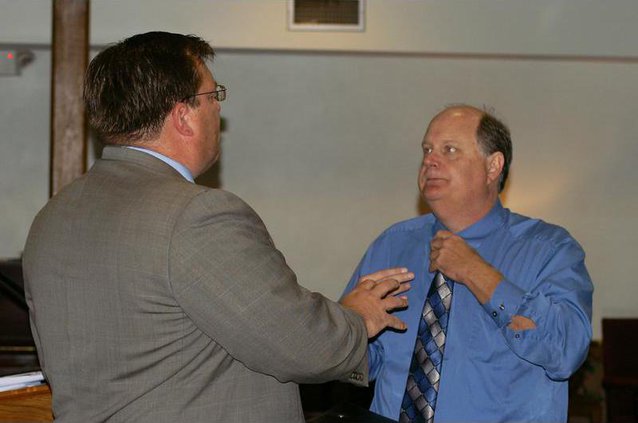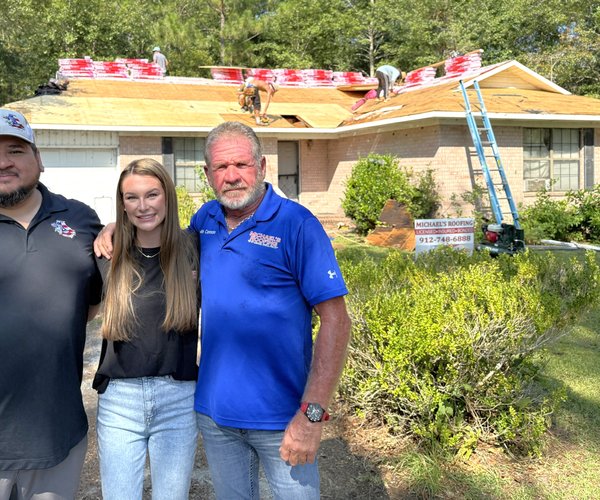Water use in north Georgia has been curtailed, and the state Environmental Protection Division is sticking to its demand to reduce the amount of water taken from the upper Floridan aquifer, Effingham Chamber of Commerce members learned Wednesday morning.
The EPD’s Jeff Larson showed Chamber members the extent of the drought across north Georgia and spelled out how the state wants to curtail groundwater withdrawal in southern parts of the state. Larson is the EPD’s Watershed Protection Branch assistant branch chief for the Savannah and Ogeechee river basins.
“We’re not asking if the water runs out,” he said. “We’re asking when the water runs out. It’s one thing to talk about it. It’s another to see it.”
According to Larson, the state has been addressing Georgia’s drought conditions for four and a half years. A drought management plan was adopted in March 2003 and water use restriction guidelines were approved the following year.
Sixty-one north Georgia counties are at level 4, which means all outdoor watering has been banned with the exception of some commercial and industrial uses. Local governments and water utilities can impose even stricter regulations than those called for by the EPD. A state of emergency has been declared in 85 counties.
Gov. Sonny Perdue has directed the EPD to institute a reduction of usage by 10 percent of permitted water consumption when compared to the average used from December 2006-March.
“We’re actively involved in that,” Larson said. “We’re watching those reductions like hawks.”
There also doesn’t seem to be any relief from the drought in the foreseeable future. Long-range forecasts call for the La Niña weather pattern to continue to dominate, leading to a warmer and drier than normal winter and spring, according to the University of Georgia’s College of Agricultural and Environmental Sciences.
“La Niña sets up the weather pattern that doesn’t allow hurricanes and tropical storms to come through,” Larson said.
Coastal counties also need to be worried about saltwater intrusion, Larson said. Elevated chloride concentrations were found in wells on the northern end of Hilton Head Island and there is also a cone of depression right under Chatham County, “a deep one,” Larson said.
“This is an upper Floridan aquifer problem,” he said.
Larson didn’t point to development as the culprit but noted that the economic boom the coastal area has had has meant increased water withdrawal needs from the upper Floridan aquifer.
The state has capped withdrawal from the upper Floridan aquifer to 2004 levels for areas in the so-called red zone, which includes Effingham County south of Highway 119, and it also mandates that level be cut by another 5 million gallons per day in 2008.
“We’ve got to go deeper with the wells and use surface water,” Larson said.
Also mandated are reuse and conservation measures for red zone areas. Bryan and Liberty counties are in what is known as the yellow zone while the area north of Highway 119 in Effingham and 19 other southeast Georgia counties are in the green zone, where withdrawal is not yet capped.
“Reuse is a cornerstone of the statewide plan,” Larson said.
The state also wants water users to look at their water meters and make sure they are working properly.
“Those things are inaccurate,” Larson said. “A lot of them don’t work.”
Larson is also part of the Georgia team that is negotiating with South Carolina officials on ways to protect the quality of the water in the Savannah River and in the Savannah harbor.
“That is my number one priority in November,” he said.
At issue the total maximum daily load, the amount of a pollutant a waterway can take and remain a viable body of water for fish and recreation.
“The new TMDL simply states, ‘everybody out of the pool,’” Larson said.
The federal government said the Savannah harbor water was in violation of a disapproved dissolved oxygen standard, one that had been in place for 18 years.
“We have to set a new standard, one that we know will be difficult at best to meet,” Larson said.
The net result is supposed to be returning the water in the river and the harbor as close to its natural state as can be determined.
“We are getting close to a resolution and closer on how to handle this thing,” Larson said.








